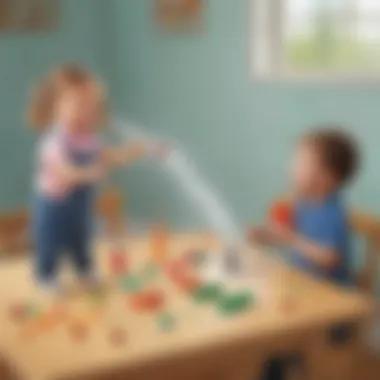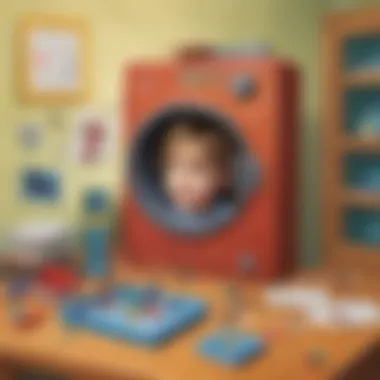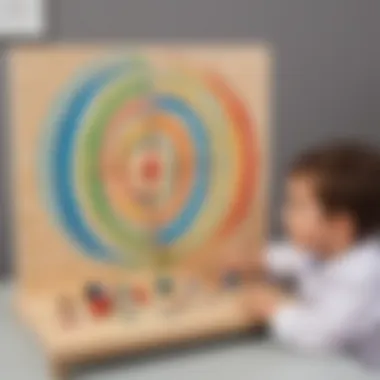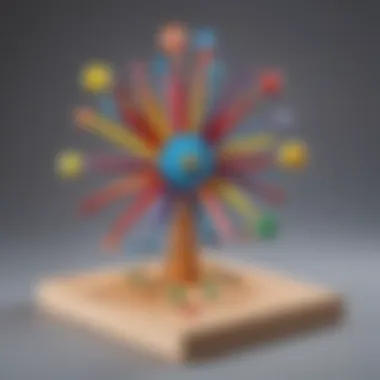Unlocking the Wonders of Preschool Magnets: A Journey of Curiosity and Learning for Young Science Enthusiasts


Science Fun Facts
Preschool magnets, although small in size, possess a mysterious force that attracts certain metals. This magnetic force creates an invisible field around the magnet, allowing it to pull or push objects without any physical contact. Understanding how magnets work opens up a world of exploration for young scientists, sparking curiosity about the unseen forces that govern our universe.
Discover the Wonders of Science
As we delve deeper into the realm of preschool magnets, we uncover the fundamental scientific concepts that govern their behavior. Through interactive simulations and captivating animations, children can witness the magnetic field in action, grasping the concept of attraction and repulsion. Discovering the real-life applications of magnets, from magnetic compasses to MRI machines, further highlights the significance and versatility of this fascinating force.
Science Quiz Time
Engage young minds with interactive quizzes designed to test their knowledge and understanding of magnets. From multiple-choice questions about magnetic poles to brain teasers challenging them to predict the behavior of magnetic objects, these quizzes provide a fun and stimulating way to reinforce learning. By gamifying the science of magnets, children can enhance their comprehension and problem-solving skills while having a blast.
Science Experiment Showcase
Prepare for an exciting journey into the world of hands-on science experiments with magnets. From constructing simple magnetic mazes to observing the effects of magnetism on different objects, these experiments offer a hands-on approach to learning. With step-by-step instructions, a detailed materials list, and essential safety tips, children can conduct experiments safely while exploring the captivating properties of magnets.
Introduction to Magnets
What Are Magnets?
Magnets are objects that produce a magnetic field, exerting attractive or repulsive forces on other materials within that field. These forces are the result of the alignment of magnetic domains within the material. Understanding what magnets are is fundamental to grasping their functionality and applications in everyday life. By exploring the basic nature of magnets, young learners can develop a solid foundation in science and engineering principles.
Types of Magnets
There are various types of magnets, including permanent magnets, temporary magnets, and electromagnets. Permanent magnets, like those found in refrigerator doors, retain their magnetic properties without external influence. Temporary magnets, on the other hand, only exhibit magnetic behavior when in the presence of a magnetic field. Electromagnets, created by the flow of electric current through a coil, are crucial components in many technological devices. Exploring these different types of magnets provides young minds with insights into the diversity of magnetic materials and their unique characteristics.
Magnetic Properties
Magnetic properties refer to the behavior of materials in the presence of a magnetic field. Key properties include magnetic attraction, repulsion, and the orientation of magnetic poles. Understanding these properties enables students to grasp how magnets interact with each other and with various objects. By delving into the magnetic properties of materials, children can gain a deeper insight into the underlying forces that govern magnetic interactions, setting the stage for further exploration and experimentation.


Exploring Magnetism
In this article, we delve into the captivating world of magnets and the fundamental concept of magnetism. Understanding magnetism is crucial as it forms the basis of various scientific principles surrounding magnets. Magnetism is the force that allows magnets to attract or repel certain materials. By exploring magnetism, young science enthusiasts can grasp the idea of how magnets work and interact with each other.
Magnetic Fields
Magnetic fields play a significant role in magnetism as they are the regions around a magnet where magnetic forces can be detected. These invisible lines of force help us visualize how magnets interact with other materials. Learning about magnetic fields enables children to understand the concept of magnetism better. They can observe how magnetic fields influence the behavior of objects around magnets and appreciate the invisible force at play.
Attraction and Repulsion
Attraction and repulsion are key phenomena in magnetism that fascinate young learners. When two magnets are brought close together, they either attract or repel each other based on their poles. This concept not only demonstrates the magnetic properties of materials but also sparks curiosity in children to explore further. Understanding attraction and repulsion helps children comprehend why magnets behave the way they do and how different poles interact.
Poles of a Magnet
The concept of poles in a magnet is essential in understanding its behavior. Each magnet has two poles, namely the North and South poles, which play different roles in magnetism. The North pole of one magnet is attracted to the South pole of another and vice versa. By learning about the poles of a magnet, children can distinguish between them and predict how magnets will interact. This knowledge sets the foundation for more advanced studies in magnetism and paves the way for engaging experiments and activities.
Fun Magnet Experiments
In this section, we delve into the engaging world of Fun Magnet Experiments. These experiments play a crucial role in helping young minds understand the magnetic properties and phenomena in a hands-on and exciting manner. By embracing these experiments, children can develop a deeper appreciation for science and enhance their critical thinking and problem-solving skills. Fun Magnet Experiments not only offer an enjoyable learning experience but also spark curiosity and foster a sense of wonder in preschoolers.
Floating Paperclip Experiment
The Floating Paperclip Experiment is a simple yet fascinating activity that demonstrates the power of magnetism. To conduct this experiment, you will need a paperclip and a magnet. Place the magnet on a flat surface and gently float the paperclip on the water surface nearby. The paperclip will appear to defy gravity and float towards the magnet, showcasing the invisible forces at play. This experiment not only entertains children but also educates them on the concept of magnetic fields and attraction.
Making a Compass
Making a Compass is an informative and interactive experiment that introduces children to the concept of navigation using magnets. To create a simple compass, you will need a magnet, a bowl of water, and a small piece of cork or paper. Rub the magnet against the cork or paper and carefully place it on the surface of the water in the bowl. The magnetized object will align itself with the Earth's magnetic field, pointing towards the North, thus acting as a basic compass. This experiment helps kids understand the functionality of a compass and the role of magnets in navigation.
DIY Magnetic Fishing Game


The DIY Magnetic Fishing Game is a creative and entertaining activity that promotes hand-eye coordination and fine motor skills in preschoolers. To set up this game, create magnetic fish cutouts using paper or cardboard and attach paper clips to them. Then, fashion a fishing rod with a magnet tied to a string. Encourage children to
Interactive Quizzes on Magnets
Understanding the significance of Interactive Quizzes on Magnets within this comprehensive guide to Preschool Magnets is crucial. By delving into Interactive Quizzes, young learners can solidify their grasp on magnetic concepts while enjoying a interactive learning experience. This section aims to combine knowledge retention with engaging activities, ensuring that children not only learn about magnets but also retain and apply this knowledge effectively. Incorporating quizzes into the educational journey helps to reinforce key concepts, test understanding, and provide immediate feedback. The interactive nature of the quizzes promotes active learning, keeping children engaged and enthusiastic about exploring the world of magnets. Through these quizzes, learners can assess their comprehension, identify areas that require further study, and track their progress. Importantly, quizzes serve as an effective tool for reinforcing learning outcomes in a fun and interactive manner, making the educational experience more dynamic and enjoyable. Utilizing Interactive Quizzes on Magnets offers a multi-faceted approach to learning while catering to diverse learning styles. By combining visual aids, multiple-choice questions, and interactive elements, these quizzes cater to visual, auditory, and kinesthetic learners, enhancing understanding and retention. Furthermore, the format of quizzes encourages critical thinking, problem-solving skills, and application of theoretical knowledge in practical scenarios. These quizzes are designed to stimulate curiosity, promote active participation, and foster a deeper appreciation for the principles of magnetism. Seek balance while creating quizzes, ensuring they are challenging yet achievable, engaging yet informative. Presenting a mix of conceptual questions, practical scenarios, and visual puzzles can add variety and depth to the quizzes, enhancing the learning experience. By embracing a diverse range of question formats, from truefalse to matching exercises, learners are exposed to different ways of processing information and demonstrating their understanding. Through thoughtfully crafted quizzes, children can actively participate in their learning journey, reinforcing their knowledge while having fun. Given the interactive nature and educational value of quizzes in this article, children can expect to embark on a delightful educational adventure filled with engaging challenges, valuable insights, and a deeper understanding of magnets.
Test Your Magnet Knowledge
Magnetism Riddles
Quiz: North and South Poles
Benefits of Magnet Play for Preschoolers
In this section, we delve into the significant benefits that magnet play offers to preschoolers, aiming to cultivate an enriching and educational experience for young minds. Magnet play serves as a gateway to understanding fundamental scientific concepts in a hands-on and engaging manner, making learning a delightful adventure for children aged 6-12. By unlocking the mysteries of magnets through play, kids not only develop essential skills but also foster a sense of curiosity and wonder about the world around them.
One key aspect of magnet play is its capability to enhance fine motor skills in preschoolers. Through activities like sorting magnetic objects or building structures with magnetic tiles, children can refine their hand-eye coordination and dexterity. The act of handling various magnetic materials encourages precise movements and grip strength, contributing to the development of fine motor skills crucial for tasks like writing, drawing, and buttoning clothes. As preschoolers manipulate magnets to attract and repel, they unknowingly strengthen their motor control abilities in an enjoyable and stimulating environment.
Encouraging curiosity and exploration is another vital benefit of engaging preschoolers in magnet play. By introducing young learners to the captivating world of magnetic forces, caregivers ignite a sense of wonder and inquisitiveness that propels children to ask questions and seek answers. Magnet play stimulates a child's natural inclination to explore, observe, and experiment, fostering a keen interest in scientific phenomena from an early age. Encouraging curiosity not only drives a child's enthusiasm for learning but also nurtures a lifelong love for discovery and investigation.
Furthermore, magnet play plays a pivotal role in promoting critical thinking skills among preschoolers. As children interact with magnets through various activities and experiments, they are challenged to problem-solve, hypothesize, and draw logical conclusions. The process of trial and error inherent in magnet play cultivates analytical thinking, spatial reasoning, and deductive skills in young learners. By exploring cause-and-effect relationships and conceptualizing abstract concepts such as magnetic fields, preschoolers engage in cognitive processes that lay the foundation for robust critical thinking abilities in the future.
Safety Tips for Magnet Activities
In the world of preschool magnets, ensuring safety during interactive play is paramount. Young learners are eager to experiment and explore, but it is crucial to implement safety measures. Safety tips for magnet activities serve as a guide to prevent accidents and promote a secure learning environment. By highlighting these crucial precautions, parents, caregivers, and teachers can facilitate a safe yet engaging experience for children.
Supervision is Key
When engaging in magnet activities, supervision plays a pivotal role in maintaining safety. By closely monitoring children during playtime, adults can swiftly address any potential hazards. Supervision not only fosters a secure environment but also allows for immediate intervention if needed. It is essential to be present and attentively watch over children during magnet play to prevent accidents.


Avoiding Swallowing Hazards
One of the critical aspects of safety during magnet activities is mitigating the risk of swallowing hazards. Small magnets pose a particular danger, as they can be mistakenly ingested by young children. To avoid such hazards, opt for larger magnets that are not easily swallowed. By selecting magnets of appropriate size and ensuring secure storage when not in use, the risk of accidental ingestion can be significantly reduced. Vigilance in this area is key to preventing potential health complications.
Keeping Magnets Away from Electronics
Another crucial safety consideration is keeping magnets away from electronics. Magnets can interfere with electronic devices, leading to malfunctions or damage. Educating children on the importance of maintaining distance between magnets and electronics is essential. By establishing clear boundaries and explaining the potential consequences of magnet-electronic interactions, caregivers can instill responsible behavior in young learners. This precaution not only safeguards the electronic equipment but also promotes awareness of magnet safety practices.
Choosing Age-Appropriate Magnets
Selecting age-appropriate magnets is vital in ensuring a safe and enriching magnet play experience for preschoolers. Age guidelines on toy packaging can offer insights into the suitability of magnets for specific age groups. By adhering to these recommendations, caregivers can provide children with magnets that align with their developmental stage. Age-appropriate magnets not only enhance safety but also contribute to a more age-relevant and enjoyable learning experience for young learners.
Conclusion
In the realm of preschool magnets, the conclusion acts as an indispensable segment that ties together the various aspects explored in this comprehensive article. This culmination serves as a summary of the key points discussed throughout the text, encapsulating the essence of magnetism for young learners aged 6-12.
Importance of The Conclusion in This Article
The significance of the conclusion lies in its ability to reinforce the foundational knowledge of magnets acquired by our young Science enthusiasts. As the concluding section, it consolidates the key takeaways from the introduction to the final safety tips, emphasizing the primary role that magnets play in stimulating scientific curiosity and exploration among preschoolers.
Specific Elements Covered
By revisiting the fundamental principles of magnets, such as magnetic fields, attraction and repulsion, and the diverse types of magnets, the conclusion solidifies the understanding of these concepts for our eager learners. Furthermore, it highlights the benefits of engaging in magnet play for preschoolers, stressing the development of fine motor skills, critical thinking, and curiosity through hands-on experimentation.
Emphasis on Safety and Considerations
Within this concluding section, a significant emphasis is placed on safety tips for conducting magnet activities with preschoolers. Supervision emerges as a crucial element to prevent swallowing hazards and close proximity to electronic devices. The selective choice of age-appropriate magnets also underscores the importance of fostering a safe and conducive environment for children to explore the captivating world of magnets.
Synthesizing Information Throughout
In synthesizing information from the entire article, the conclusion acts as the compass that guides young learners through a journey of discovery and learning. It consolidates the foundational knowledge, practical experiments, interactive quizzes, and safety considerations, culminating in a holistic understanding of magnets and their educational value for preschoolers.
By reiterating key concepts, emphasizing safety precautions, and encapsulating the essence of magnet exploration, the conclusion serves as a pivotal component in solidifying the educational experience for our budding Science enthusiasts.
Engage with the conclusion to wrap up your immersive exploration of the fascinating world of preschool magnets!







